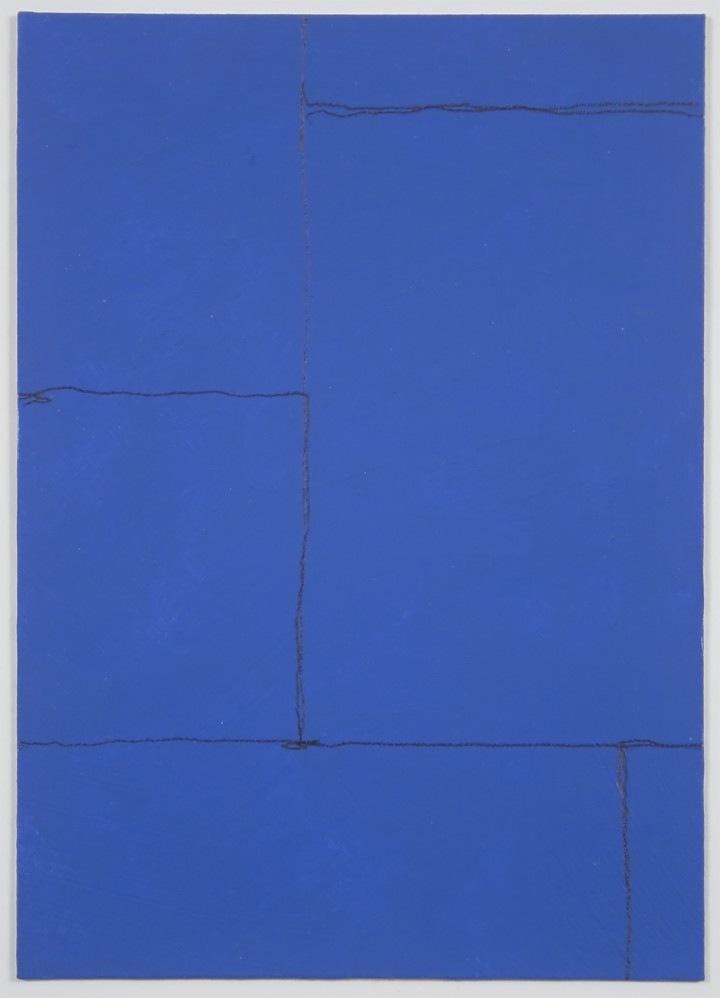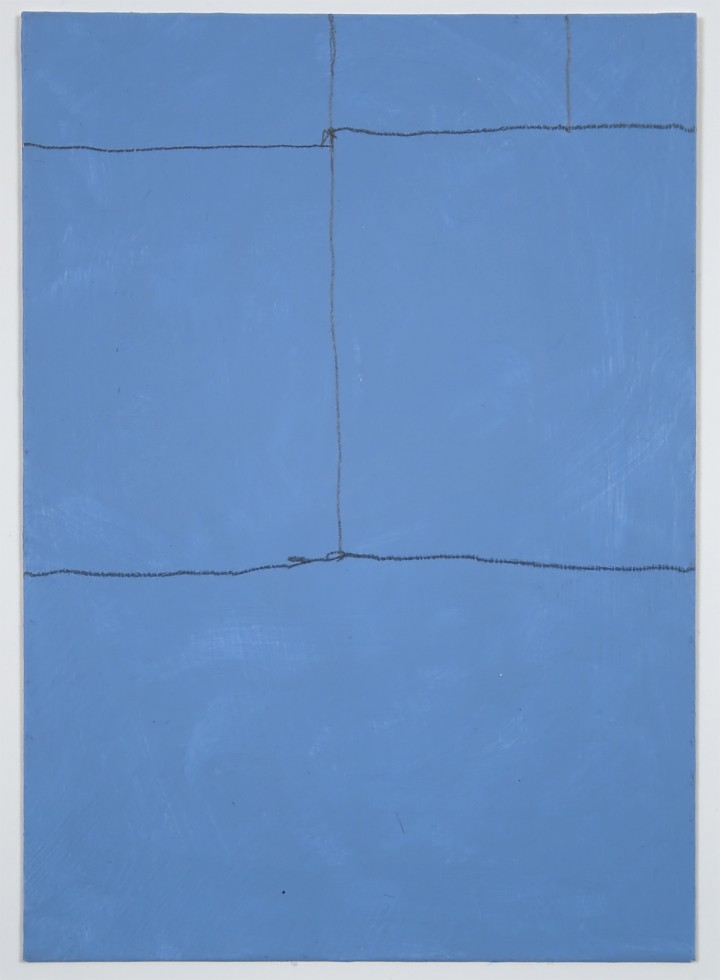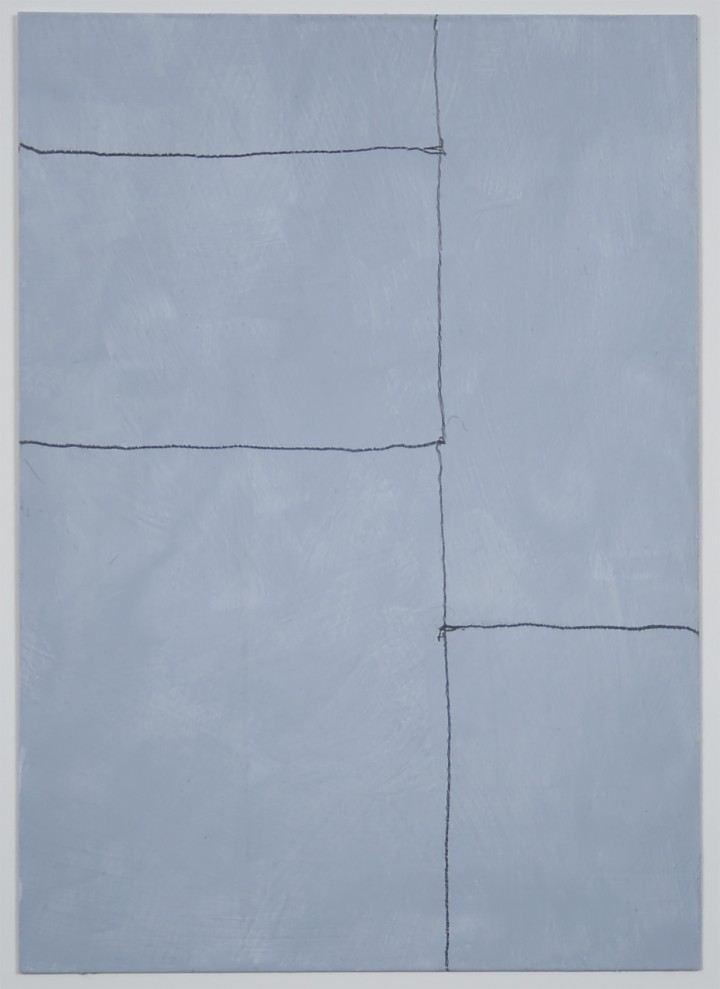
Figure 1. Martin Noël, Untitled from the Freundlich series, 2007
Acrylic and graphite on postcard, 6 x 4 1/2 inches (15.2 x 11.4 cm)
© 2012 Martin Noël. Courtesy Margarete Noël

Figure 2. Martin Noël, Untitled from the Freundlich series, 2007
Acrylic and graphite on postcard, 6 x 4 1/2 inches (15.2 x 11.4 cm)
© 2012 Martin Noël. Courtesy Margarete Noël
Martin Noël
by Amanda Beresford
Born in Berlin in 1956, Martin Noël trained in Cologne, becoming one of the leading figures of the Rhineland art scene in the 1970s. He was active in Bonn as a painter, draftsman, and printmaker in woodcut until his death in 2008. Transcendence has been described as a central theme of Noël’s work.1 These four drawings from the Freundlich series (figs. 1-4), executed in the year before his death, could be interpreted as reflections on an ideal or transcendent state, but they also display parallels with the use of seriality as a strategy in art of the 1960s and 1970s: the repetition or elaboration of a few elements in a process of continual, seemingly random realignment; the sense of infinite variability that this engenders; the works’ coherence as a group; and the notion of the progressive metamorphosis of a central theme in search of its ideal form.2 Devoid of the mechanical or systematic detachment particular to Minimal and Conceptual serial imagery, Noël’s work is organic, instinctual, and informed by his private vision.
The drawings consist of four simple but mysteriously compelling compositions of horizontal and vertical lines intersecting at right angles, drawn freehand on standard-size postcards. The background colors of the postcards deepen gradually from off-white to slate blue-gray to a rich cornflower blue to an intense cobalt. The play of asymmetrical horizontals and verticals in the drawings varies subtly but markedly, each offering a different dynamic of just four lines in the first three images and of five in the fourth. The dominant vertical line shifts from the left in the first drawing to the right in the second, each with three horizontal branches extending to the outer edge of the postcard. The third drawing presents two equal horizontals that traverse the width of the card, supporting two shorter verticals, with an empty space occupying almost the entire lower half. A greater equilibrium in the length and placement of lines and in the areas that they define is achieved in the fourth drawing, giving a sense of unequal, opposing forces held in balance. The drawings’ depthless picture planes read either as lines precisely arranged on a field or as a field divided into irregular but complementary tesserae.

Figure 3. Martin Noël, Untitled from the Freundlich series, 2007
Acrylic and graphite on postcard, 6 x 4 1/2 inches (15.2 x 11.4 cm)
© 2012 Martin Noël. Courtesy Margarete Noël

Figure 4. Martin Noël, Untitled from the Freundlich series, 2007
Acrylic and graphite on postcard, 6 x 4 1/2 inches (15.2 x 11.4 cm)
© 2012 Martin Noël. Courtesy Margarete Noël
Together with the deepening chromatic intensity of the postcards, the choreography of linear configurations suggests a progression through a series of increasingly powerful emotional states. This intensity is amplified by Noël’s elegant, febrile line. His touch is simultaneously tentative and assured; his expressive strokes, with their intricate junctions, are highly idiosyncratic. If this is a quest for transcendence, it is communicable only through strict abstraction, a condensation of reality to its essence. These are not diagrams for finished artworks, although they are closely related in composition to some of Noël’s large paintings; they are works of art in their own right, with the authority to exist independently as well as in series. Each individual work possesses, according to John Berger, “a unique, one-time-only, physical presence,” giving it the quality of a portrait.3 Each work is both a singular entity and an organic part of a larger whole.
Noël’s drawings and the paintings to which they relate evoke associations with the natural world. This series suggests trees branching in Mondrian-like abstract patterns against a sky modulated by changing moods of light and shadow, or perhaps by the extensions of a moving human body. Meaning resides in the subtle variations among the works, in the changing directions of the lines that, as Berger observes, “are always leading somewhere else.”4 Where else is the question at the core of the works’ mystery.
Notes
1. See the artist’s website, http://www.martinnoel.de/werkauswahl/index.html.
2. Nicholas de Warren, “Ad Infinitum: Boredom and the Play of Imagination,” in Infinite Possibilities: Serial Imagery in Twentieth-Century Drawings (Wellesley, MA: Davis Museum and Cultural Center, 2004), 11.
3. John Berger, “Branching Out,” in Martin Noël: Blau und andere Farben, ed. Peter Dering (Ostfildern-Ruit, Germany: Hatje Cantz, 2003), 45–51.
4. Ibid., 45-51.
Bios
Amanda Beresford
Martin Noël
